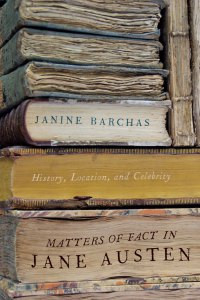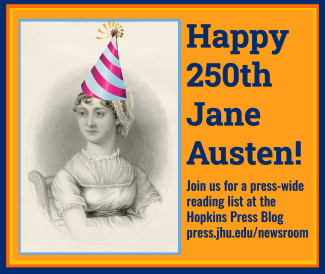
Johns Hopkins UniversityEst. 1876
America’s First Research University
Will the real model for Pemberley please step forward?
Guest post by Janine Barchas Today marks the start of the annual gathering of the Jane Austen Society of North America (JASNA), hosted this year in Minneapolis. This particular meeting celebrates the bicentennial of Pride and Prejudice (first published in 1813) with the pomp that is due this standout literary favorite, including workshops, exhibits, lectures, readings, and, of course, a Regency-style ball. Because I recently published a book about Jane Austen as a consummate name-dropper and participant in early celebrity culture, I was invited to speak to JASNA members about the celebrity currency of the names in Pride and Prejudice .
This post is a sneak peek into the new research that I will be sharing with JASNA members about how specific surnames and locations in Pride and Prejudice slyly point to the ancestral home of the real-world Fitzwilliam and Darcy families—directing a reader’s encounter with the fictional estate of Pemberley.
Now, the name “Jane Austen” has become such a dominant celebrity commodity that we read her work by the light of her own fame (or the glow of the bonnet drama!). Today, the names Fitzwilliam Darcy and Bingley have become so famous in their own right as to shine from within, casting a Janeite shadow over the genuine personages who held these names during Austen’s lifetime. In 1813, the renowned names of Bingley, Darcy, and Fitzwilliam—doled out slowly and deliberately by Austen in Pride and Prejudice—would have tantalized any educated reader with their obvious cachet. To see how names tease in Pride and Prejudice, you have only to turn to the opening scene, where a leading surname points directly north. Here Mrs. Bennet announces the arrival of “a young man of large fortune from the north of England.” “What is his name?” asks Mr. Bennet. “Bingley,” she answers.
As a timeless literary abstraction, the young bachelor’s arrival hails the novel’s marriage plot. Figuratively, his northern wealth is brought “down” to the genteel south (Longbourn is, we are told, in Hertfordshire) to settle and age there—like a fine wine. By settling at the aptly named Netherfield Park, Bingley and his new money will eventually become socially palatable. The young man’s surname neatly reinforces this symbolic geography with a concrete clue, since the town of Bingley, then as now, lies in the northern county of Yorkshire. All this is as transparent today as it was in 1813 when the novel was first published. However, in its original Georgian context, the surname of Bingley, when coupled with a reference to northern wealth, would also have conjured up Baron Bingley of Bramham Park in West Yorkshire—frequently in the papers as hosting the Prince Regent. In Austen’s novel, we soon learn that Mr. Bingley’s best friend is the far-wealthier Mr. Darcy, a surname that further reinforces north-meets-south tensions since “the Lords D’Arcy of the North” comprised an ancient wealthy family in the peerage.
It is only with the delayed entrance of Mrs. Gardiner into the story that a reader of Pride and Prejudice learns the hero’s full name: “she recollected having heard Mr. Fitzwilliam Darcy formerly spoken of as a very proud, ill-natured boy.” This big reveal of the hero’s Christian name in volume two clinches the real-world allusion by ringing a third celebrity bell. In real life, the bling of the Bingleys in Yorkshire was nothing compared to the splendor of the Fitzwilliams, who lived just forty miles south, near the Derbyshire border. Their home was measurably the grandest in England, with 1000 windows and a façade twice the length of Buckingham Palace. These real Fitzwilliams boasted ancestors dating back to the time of William the Conqueror, prominently including the ancient D’Arcy family. Once is happenstance. Twice is coincidence. But three times is an enemy action.
In the late 1980s, scholars first suggested Chatsworth as the inspiration for Pemberley, because of its Derbyshire location and the association with the name Georgiana (Darcy’s sister shares this name with the famous Duchess of Devonshire, who lived there until 1806). For two decades this suggestion has been enthusiastically fanned by Chatsworth’s own tourist industry. The 2005 film version of Pride and Prejudice further strengthened the association when it cast Chatsworth as Pemberley. Instead, I believe that, while Austen flirts with Chatsworth as a historical referent, she also takes pains to eliminate it as a contender when she names it in her story as one of the “principal wonders” of the area visited by Elizabeth Bennet and Mr. and Mrs. Gardiner during their “northern tour.” The novel tracks the travelers’ steady northward progress through “Oxford, Blenheim, Warwick, Kenelworth, Birmingham, &c.” When the travelers reach Derbyshire, we are told that “the celebrated beauties of Matlock, Chatsworth, Dovedale, or the Peak” are no match for Mrs. Gardiner’s love of Lambton, the fictional town adjoining Pemberley. Even for a reader not as conversant with England’s geography as Austen, GoogleMaps quickly confirms that the characters of Pride and Prejudice proceed slowly northward to Pemberley via all these real places.
After a named appearance in the story as a real location, Chatsworth cannot also stand in for the imaginary Pemberley. A successful illusion forbids such double dipping: in Gotham City no one speaks of New York. Just so, in Mrs. Gaskell’s North and South, the people of an industrial town called Milton speak knowingly of London and Oxford but never Manchester. In a fictional stand-in for a well-known location, characters do not visit or discuss the implied referent. To do so would break the spell. Perhaps Austen brings her Elizabeth to Chatsworth so that readers will look around, somewhere nearby, for another implied referent or inspiration?
In 1813, Chatsworth’s greatest rival in beauty was located less than a morning’s ride away, just across the border into Yorkshire. Already by the 1770s, many travelers, including William Gilpin, whom Austen admired, judged Chatsworth, by contrast, as rather outdated. Sadly, Chatsworth’s neighboring rival, once world-renowned for its stunning architecture and influential landscape gardens, suffered great injury from strip-mining during the twentieth century. Two centuries have therefore diminished the fame and glory of this other location, depriving it of the public-relations benefit that now falls to the settings chosen for Austen films. Ambitious restoration plans, including a hotel by 2015, may soon put it back on the tourist map. With specific names and distances pointing the way in Pride and Prejudice, Austen’s fictional Pemberley invokes, I hope my fellow Janeites will agree, the ancestral home of the real Fitzwilliam and Darcy families: Wentworth Woodhouse (aka, simply, “Wentworth House”).

Austen would eventually pluck many additional family surnames from the same Wentworth Woodhouse family tree for her characters in later books—including “Woodhouse” in Emma (1815) and “Wentworth” in Persuasion (1817). This is precisely what tipped me off to this Yorkshire location in the first place during the research for my book.
Janine Barchas was recently on Minnesota Public Radio talking about JASNA and why Austen's work has endured generation after generation.



